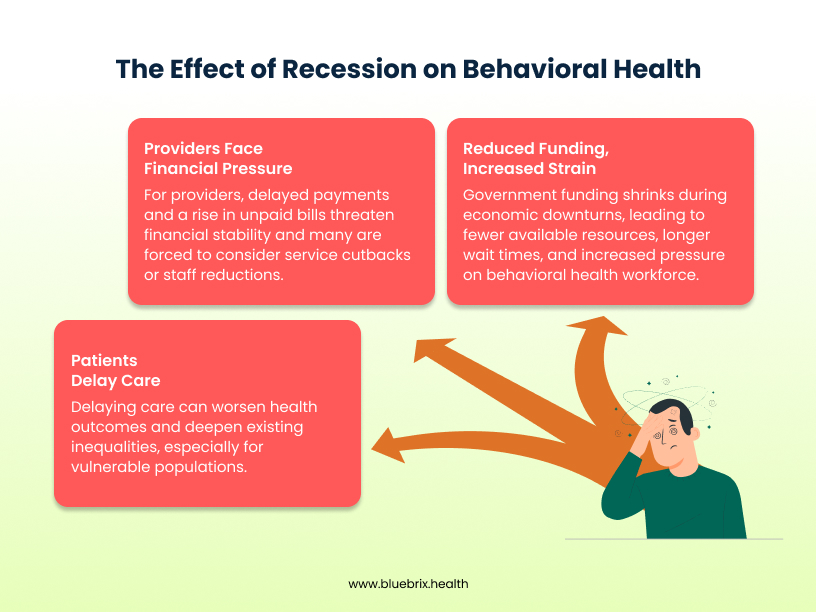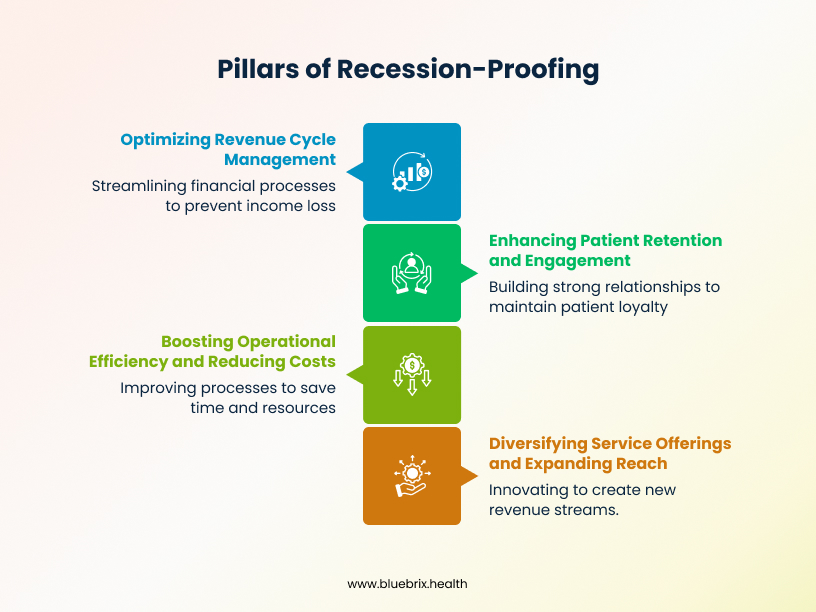Economic downturns can hit healthcare hard—especially behavioral health. Learn how smart strategies and tech can help your clinic stay financially strong, improve patient care, and stay stable no matter the economy.

During economic recessions, every sector feels the squeeze, but healthcare faces a distinct set of vulnerabilities. Unlike other industries where demand might simply dissipate, the need for essential services, particularly in behavioral health, persists and even increases. Yet, the ability of patients to pay and the system’s capacity to deliver equitable care are significantly compromised.
So, how can your clinic withstand these pressures? The answer lies in leveraging technology to build a robust, multi-faceted defense against economic volatility.
The Vulnerabilities of Healthcare During a Recession

Healthcare systems face a set of vulnerabilities during economic recessions, impacting both patients and providers in ways that differ from other sectors. Here’s a look at the distinct challenges healthcare faces during an economic downturn:
Patients Face Tough Choices
Economic downturns bring job losses and shrinking household incomes, forcing individuals to prioritize essentials like rent and groceries over behavioral health needs. As a result, therapy sessions, psychiatric evaluations, and medication adherence are often delayed or skipped altogether. While these decisions may reduce immediate expenses, they tend to worsen mental health conditions over time—ultimately increasing long-term costs and risks.
Vulnerable populations—such as low-income families, the unemployed, migrant workers, and single-parent households are hit hardest.
Providers Struggle with Financial Instability
When patients delay care, behavioral health providers—especially smaller clinics and community mental health centers—feel the strain. Revenue declines due to fewer appointments and higher levels of uncompensated care. Unlike large hospitals, behavioral health practices often lack financial buffers, making them more susceptible to service cutbacks, staff reductions, or even closure.
Additionally, behavioral health services are typically reimbursed at lower rates than physical health services, further amplifying financial risk during economic downturns.
Funding and Workforce Constraints
During recessions, government budget cuts often impact behavioral health disproportionately. Public programs like Medicaid may face tighter eligibility or reduced reimbursement rates, while grant funding for mental health initiatives may be delayed or withdrawn. This creates a resource squeeze—just as demand for behavioral health services surges due to economic stress, unemployment, and rising anxiety and depression rates.
The workforce also feels the pressure because essential behavioral health roles are not immune to layoffs, burnout, or wage stagnation, especially in underfunded regions or organizations dependent on public funding.
To thrive during recessions, proactive and strategic planning is key.
The Core Pillars of Recession-Proofing for Behavioral Health Clinics
Recession-proofing isn’t a single action; it’s a multi-faceted approach built upon several essential pillars listed below:

Optimizing Revenue Cycle Management – The revenue cycle is the lifeblood of any clinic. Inefficient RCM is like a leaky faucet, constantly dripping away potential income. During a recession, these leaks become even more critical. Slow payments, denied claims, and administrative errors can significantly erode profit margins, especially when patient volumes or spending are already under pressure.
Enhancing Patient Retention and Engagement – In a tight economy, retaining existing patients is often more cost-effective than acquiring new ones. Loyal clients are your most valuable asset. When financial pressures mount, patients may “shop around” for more affordable services. A strong, positive relationship with your clinic fosters loyalty and reduces churn.
Boosting Operational Efficiency and Reducing Costs – Doing more with less is important during economic downturns. This often involves manual processes, redundant tasks, and outdated systems that consume valuable staff time and resources.
Diversifying Service Offerings and Expanding Reach – Recessions can also be a catalyst for innovation. Diversifying services and expanding your reach can open new revenue streams.
How blueBriX helps recession-proof your clinic
blueBriX is built from the ground up to address the core pillars of recession-proofing, providing a comprehensive, integrated solution that safeguards your revenue, optimizes operations, engages patients, and fosters growth.
Intelligent Revenue Cycle Management for Revenue Resilience
blueBriX equips your clinic to maintain consistent cash flow, even during economic turbulence with:
- Automated Eligibility Verification and Prior Authorizations: Catching eligibility issues and securing prior authorizations before a service is rendered dramatically reduces claim denials, saving time and money.
- Smart Coding and Billing Rule Engines: Automated systems can identify coding errors and ensure compliance with ever-changing payer rules, leading to cleaner claims and faster reimbursement.
- Denials Management and Appeals Automation: Technology can streamline the entire denials management process, from identifying the root cause of denials to automating appeals, ensuring you recover as much lost revenue as possible.
- Real-time Payment Tracking and Reconciliation: Gaining real-time visibility into payment status allows for proactive follow-up on outstanding balances and more accurate financial forecasting.
Patient Retention Engine
blueBriX makes keeping your existing patients engaged seamless by:
- Streamlined Scheduling and Appointment Reminders: Easy online scheduling and automated reminders reduce no-shows and improve patient access.
- Secure Patient Portals for Communication and Education: A patient portal empowers patients to manage appointments, access information, and communicate securely with their providers, fostering a sense of control and engagement.
- Personalized Outreach and Follow-up: Automated, personalized messages for follow-up appointments, medication reminders, or educational content demonstrate care and keep patients engaged in their treatment journey.
- Telehealth for Accessibility and Convenience: Offering telehealth options removes geographical and logistical barriers, making care more accessible and convenient, which is highly valued during economic uncertainty.
Purpose Built Care Management Solution
blueBriX streamlines day-to-day workflows without compromising quality in care with:
- Digital Intake Forms and Consent Management: Moving away from paper forms saves printing costs, storage space, and significant staff time spent on data entry.
- Automated Reporting and Analytics: Generating reports manually are time-consuming and prone to error. Automation provides accurate, real-time insights into clinic performance.
- Staff Scheduling and Resource Management: Optimized scheduling systems ensure appropriate staffing levels, reduce overtime, and improve overall resource utilization.
Growth-Ready Platform for Diversification
Whether you’re launching new service lines or expanding to new markets, blueBriX scales with your ambitions with their ability to do the following:
- Rise with Telehealth and Hybrid Care Models: The pandemic accelerated the adoption of telehealth, and it’s here to stay. Hybrid models, combining in-person and virtual care, cater to diverse patient needs.
- Expanding into Niche Areas: Specializing in areas like Substance Use Disorder (SUD) treatment, trauma-informed care, or services for specific populations (e.g., adolescents, seniors) can tap into underserved markets.
- Group Therapy and Digital Programs: Group therapy offers a cost-effective treatment modality for both patients and clinics. Digital programs, such as online courses or workshops, can provide scalable revenue opportunities.
- Opportunities for Value-Based Care Models: Moving towards value-based care, where reimbursement is tied to patient outcomes rather than just volume of services, can align incentives and potentially lead to more stable revenue streams in the long run.
Building a Resilient Future for Your Behavioral Health Clinic
Economic headwinds are inevitable, but their impact doesn’t have to be devastating. For behavioral health clinics, moving beyond mere survival and positioning themselves to thrive in any economy requires a strategic approach that harnesses the power of technology.
Clinics that invest wisely in technology will weather economic storms and emerge stronger, more efficient, and more competitive. Ready to gear up your practice against economic uncertainty and ensure a stable, thriving future?
Our comprehensive and integrated solution provides the tools and support necessary to recession-proof your behavioral health clinic, allowing you to focus on providing exceptional care to your community.